Categories
Subjects
Authors
Artists
Venues
Locations
Calendar
Filter
Done
June 21, 2018 – Review
Guy Mees’s “Espace Perdu (Verloren Ruimte)”—an exhibition in two chapters
Helena Tatay

Guy Mees (1935–2003) was a leading figure of the Belgian avant-garde whose enigmatic work combined formal diversity with conceptual rigor. A consecutive pair of exhibitions at Barcelona’s ProjecteSD—the first from March to April, the second from May to June—shed light on his career, offering carefully curated series of works alongside archival materials that situate his practice in a wider art-historical background. Mees’s interest in serial structures, repetition, formal reduction, and industrial materials was in some ways typical of minimalism. But as these two exhibitions attest, his highly personal artistic language balanced formal rigor with fragile materials—stretched lace, pale neon, narrow strips of paper—to lend his work its characteristic delicacy.
Each exhibition loosely corresponds to a distinct period in Mees’s career, during which he produced a series of works under the collective title “Verloren Ruimte” [Lost Space]. The first group, made between 1960 and 1967, feature simple, geometric wood and aluminum sculptures overlaid with industrial lace. The second, which Mees began in the mid-1980s and completed in the mid-1990s, is looser and more vivid, comprising strips of colored paper pinned to the wall. Despite their formal differences, both series investigate the relationship between art objects and their exhibitionary environments. Displaying these works …
March 19, 2018 – Review
Allora & Calzadilla
Mariana Cánepa Luna
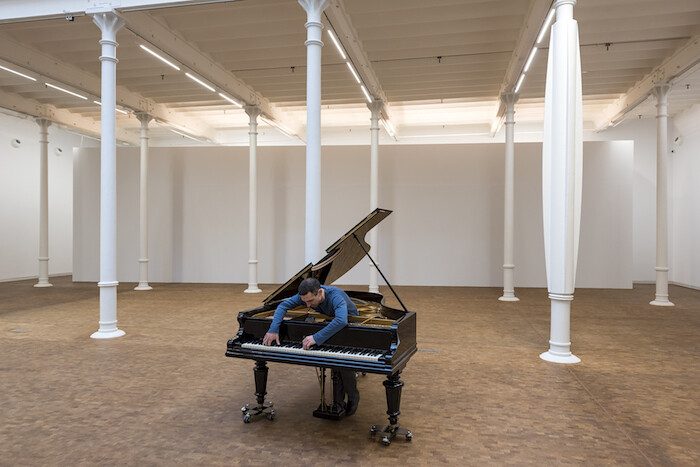
A piercing whistle punctuates the blaring of a trumpet. But in the columned central space of the Fundació Antoni Tàpies, the only visible instrument is a grand piano. For three days a week throughout the course of the exhibition, the instrument is played—and, one could say, worn—by a pianist who stands in a hole cut into its center. Leaning over the rim of the piano to strike the keys, the performer energetically interprets the fourth movement of Ludwig van Beethoven’s Symphony No. 9 (1824), while slowly pushing the wheeled instrument around the space. The building has become a musical box, the exhibition orchestrated so that one movement flows into the other, spilling through the gallery’s spaces to create a dissonant soundscape.
The piano of Stop, Repair, Prepare: Variations on Ode to Joy for a Prepared Piano (2008) could be thought of as the lead performer of Puerto Rico-based duo Allora & Calzadilla’s show. Popularly known as “Ode to Joy,” Beethoven’s piece has often been interpreted as a defense or celebration of humanist values, and in 1985 the European Union adopted it as its official anthem. Yet, as Slavoj Žižek has noted, the tune’s “universal adaptability” has made it vulnerable to use …
January 9, 2018 – Review
Holly White’s “Orange World”
Lizzie Homersham
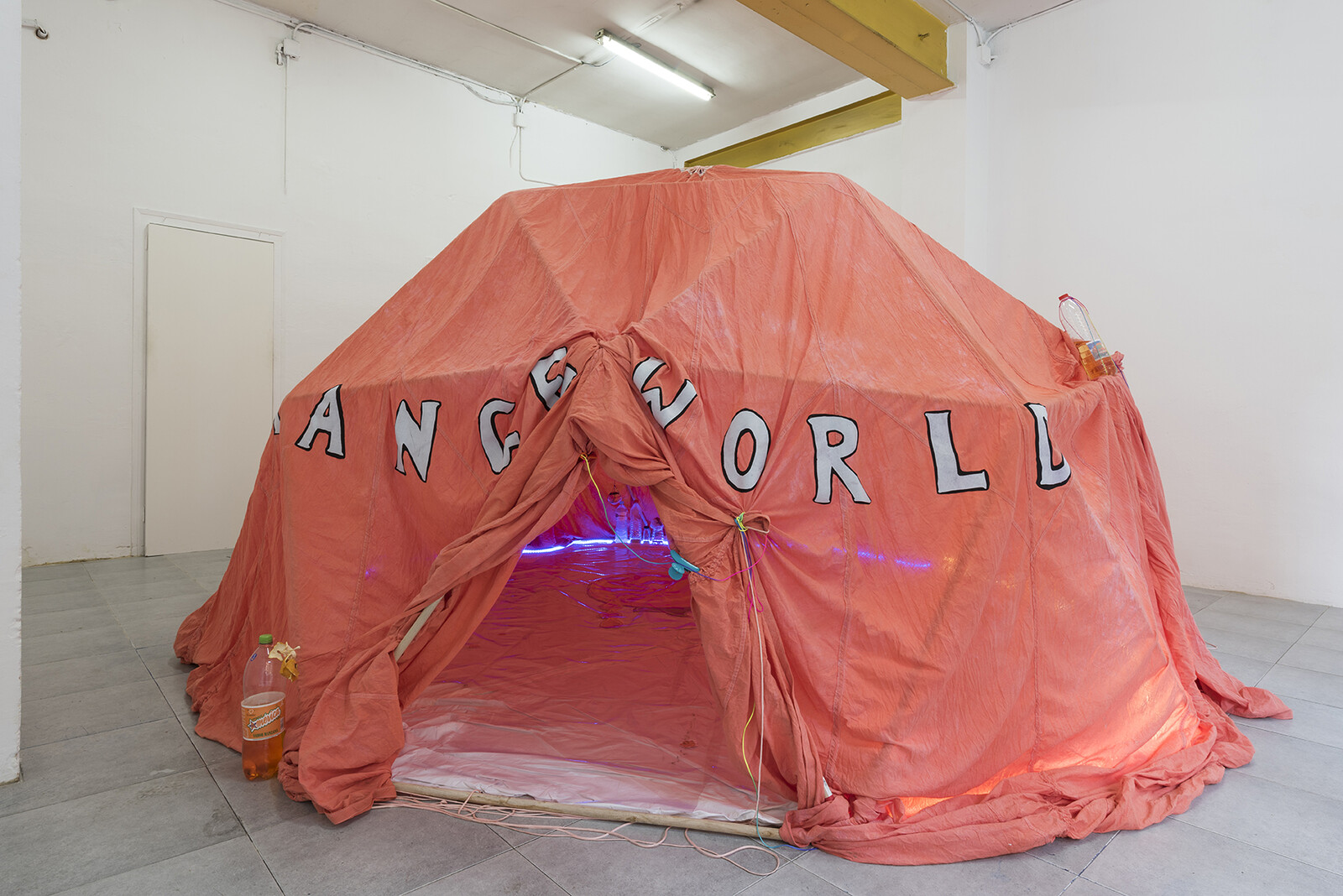
“If you believe you’re a citizen of the world, you’re a citizen of nowhere. You don’t understand what the very word ‘citizenship’ means.” I was sent into a cold rage when I read these words what feels like a never-ending day ago in the transcript from Theresa May’s Conservative Party Conference speech of October 2016. The sentences still reverberate. Supposedly they targeted “people in positions of power [who] behave as though they have more in common with international elites than with the people down the road, the people they employ, the people they pass in the street.” They simultaneously scorned free movement, no-borders politics, and international solidarity. For those opposed to the Leave campaign’s catalyzing effects on xenophobia, disinvestment, and abstract nationalist desire to “take back control,” a heavy blow to hope had already been struck by the vote back in June. Following her appointment as prime minister, May’s formal response to the referendum result set the electorate’s action into cruel and condescending relief.
“Orange World” opened in Barcelona two months after the Catalan referendum for independence from Spain. During my stay there, the city is punctuated by pro-independence yellow ribbons tied to railings or graffitied onto walls. Apartment buildings are …
September 15, 2017 – Review
“The Space of Dreams”
Ingo Niermann

Earlier this summer, after a public talk between Elena Sorokina and my wife, Chus Martínez, the three of us were invited by Eduard Mayoral of Galeria Mayoral to dinner. We hadn’t yet reached dessert when Eduard asked us what to make of Salvador Dalí. They were about to open a group exhibition, “The Space of Dreams,” curated by poet Vicenç Altaió, that would include Dalí’s work. Last year the gallery had also exhibited a series of six of Dalí’s fashion sketches from 1965, with elegantly absurd designs for beachwear and evening robes. These drawings were still for sale for 100,000 euro each.
Apart from his major paintings, the market for Dalí remains murky. Not only did he flood the market by signing all and everything, his historical importance is also in question. When I interviewed Boris Groys in 2010, he used Dalí as a perfect example of an artist who didn’t manage to appeal to both “the mass public and the informed part of the audience.” “Dalí overdid it, lapsed too far into poor taste and did not stand in any central tradition.”
The typical counter-example of someone catering to the art elite and the masses equally (who Groys also mentioned) is …
November 8, 2016 – Review
Ana Jotta’s “Abans que me n’oblidi (Before I forget)”
Mariana Cánepa Luna

While it has been widely exhibited in her native Portugal, Ana Jotta’s work hasn’t been presented in depth to the Barcelona public since the early 1990s. So this mini-survey of her production from 1980 to the present, framed as part of the Barcelona Gallery Weekend, is overdue. “Abans que me n’oblidi (Before I forget)” begins (or ends) at the intermediary patio space that one crosses before entering the main exhibition space at ProjecteSD. Part of a curved wall is covered with irregular patches of light gray and pale pink paint, as if emulating swatch tests for a redecoration. This playful gesture sets the tone for the exhibition inside, a somber and subtle palette of delicate intonations and provisional arrangements.
A dozen pieces are sparingly hung around the perimeter of the exhibition space. A large aquatint depicts a delicate wire fence (Untitled, 2002) and a portable projection screen is covered with a torrent of black-and-white strokes (Un Printemps 2008, 2008). This is the only work in the exhibition that appears to confirm Jotta’s own reductive description of herself as a painter, despite having tackled all manner of craft, from embroidery to writing. The sleek finish of the blue steel wall piece Cloud …
June 28, 2016 – Review
Loop Barcelona
Lucy Reynolds
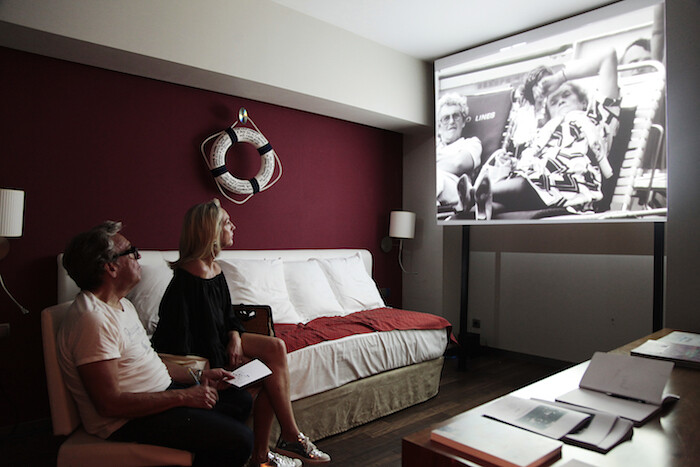
Barcelona’s Loop art fair, which started in 2003, is the oldest and most established initiative to assert the commercial potential of film and video. The medium’s ephemeral nature, and its associations with the very different market values of cinema, have contributed to a continued reluctance from collectors, attracted by the aura of more traditional art forms. Paradoxically, these tricky market credentials have recently endowed the moving image with a critical cachet in institutional art spaces and museums. As the institutional assimilation of practices traditionally seen as marginal, and oppositional, to the art market continues—from experimental film to the documentary—the instrumental role of film and video takes on a significant historical resonance in art discourse. In order to assign value to this wayward and ambiguous media within the context of an art fair, Loop has to negotiate a conflicted territory. How to maintain its more market-driven function without appearing to dismiss these historic discourses of disavowal, which will themselves provide validation for the sale of moving image works?
I received the answer at my hotel desk, where I received the exhibition catalogue for “Empathy,” Harun Farocki’s show at the Fundació Antoni Tàpies. The enclosed compliment slip asserts Farocki’s role as a “close …
January 30, 2015 – Review
Jochen Lempert
Carles Guerra
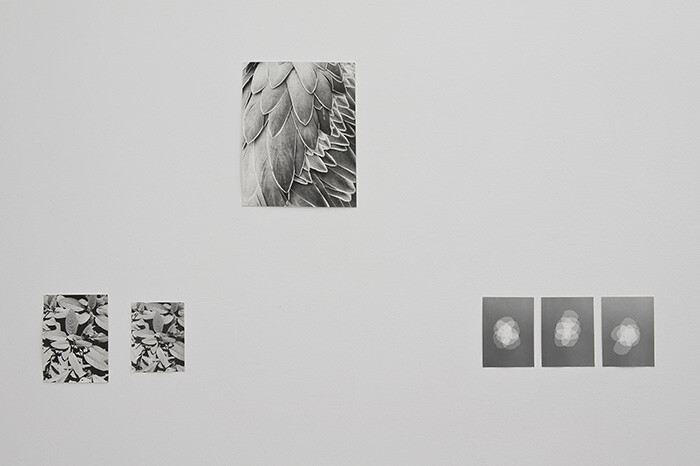
Jochen Lempert’s work is often presented in large compositions of black-and-white photographs demanding close inspection. This time is no different. Ranging from medium-sized to small and tiny prints, this exhibition of his now classic repertoire of flora and fauna gives visitors the feeling of being at an amateur’s show, where the standards of high-end presentation have been disregarded. Since the early 1990s Lempert has been known as the photographer who was once a biologist, and with this knowledge the scale of the gallery space seems ideal; a room not big enough to belittle such subtle work, which could easily be confused with scientific materials of a lesser order. Although most of the photographs in the show are organized in diptychs, triptychs, and series including several pictures, the visitor is easily drawn into the detail. A few steps away from the wall it all looks like a harmonious world: natural objects from different orders merge into seamless forms.
But upon closer examination paradoxical connections manage to unsettle what at first glance seemed unproblematic. A shelf with eight photographs and one photogram (Botanical Box [2014]) emblematizes this type of composition. Among the diverse typologies of leaves depicted there sits a blurry reproduction of …
November 21, 2014 – Review
Harun Farocki’s “4 films from 1967–1997. An homage curated by Antje Ehmann”
Carles Guerra

This exhibition is one of the first since Harun Farocki’s unexpected death in July. In the absence of the artist himself, “4 films from 1967 to 1997” pays tribute to the man—chosen by his partner and collaborator, Antje Ehmann—who has been perhaps among the most influential artists and filmmakers of the second half of the twentieth century. However, this is a reputation gained by a modest and straightforward output, as is reflected by this presentation at àngels barcelona. Three of the works emerge from a single-channel video monitor and another is projected onto the wall. The unassuming atmosphere is the perfect setting for this 76-minute program bringing together examples from Farocki’s varying and strategic forms of narrative, from militancy to critique. The Words of the Chairman (1967) and Their Newspapers (1968) recall the agitprop and politically informed practices in art and film of the late 1960s; whereas Jean-Marie Straub and Danièle Huillet at Work on a film based on Franz Kafka’s “Amerika” (1983) and The Expression of Hands (1997) are representative of his strong and analytical approach to film culture.
This is the same gallery where early installations of Serious Games (2009–2010) and Parallel I-IV (2012–2014) were presented at different stages …
July 17, 2014 – Review
Andrea Büttner’s "Tische"
Max Andrews / Mariana Cánepa Luna
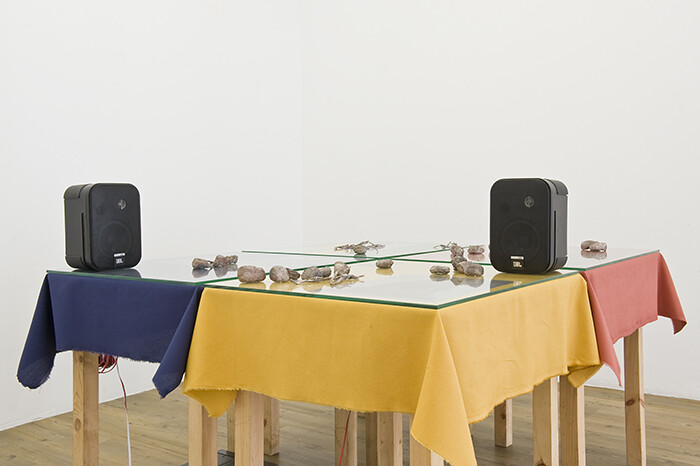
Pursuing a clearly spiritual approach within a Christian cultural and ethical context, Andrea Büttner is one of the few contemporary artists who could plausibly cite St. Francis of Assisi, the twelfth-century Catholic friar who committed himself to a life of poverty, as a key influence. Her work Tische [Tables] (2013), which addresses notions of the “blessed poor” (those who disavow material possessions as a way of being closer to God) and the prehistory of farm-to-table dining, is a carefully constructed homily on what art can bring to the table on poverty, without ever lapsing into austerity chic. Büttner’s meager solo presentation at Barcelona’s NoguerasBlanchard forms part of a year-long exhibition series entitled “The Story Behind,” organized by in-house curator Direlia Lazo. In it, the artist exhibits four out of the original thirteen tabletop compositions she created for a dinner held at the Museum für Moderne Kunst Zollamt in Frankfurt last year. At Büttner’s invitation, five talks were given at dinner and recorded. Entitled Tischreden [Dinner speeches] (2013), the resulting extended audio recordings of the speeches and the ebb and flow of dinner conversation now serve as prime stimulants for the discursive appetites of the Barcelona gallery’s visitors.
Büttner’s four dining tables—and …
